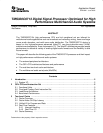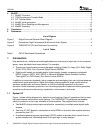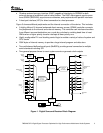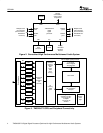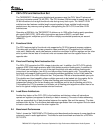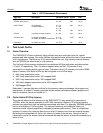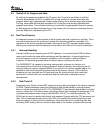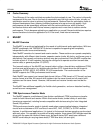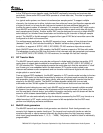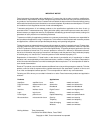
SPRA921
9
TMS320C6713 Digital Signal Processor Optimized for High Performance Multichannel Audio Systems
In the TDM synchronous transfer mode, the McASP continually transmits and receives data
periodically (since audio ADCs and DACs operate at a fixed-data rate). The data is organized
into frames.
In a typical audio system, one frame is transferred per sample period. To support multiple
channels, the choices are to either include more time slots per frame (and therefore operate with
a higher bit clock) or to keep the bit clock period constant and use additional data pins to
transfer the same number of channels. For example, a particular six-channel DAC might require
three McASP serial data pins; transferring two channels of data on each serial data pin during
each sample period (frame). Another similar DAC may be designed to use only a single McASP
serial data pin, but clocked three times faster and transferring six channels of data per sample
period. The McASP is flexible enough to support either type of DAC but a transmitter cannot be
configured to do both at the same time.
For multiprocessor applications, the McASP supports a large number of time slots per frame
(between 2 and 32), and includes the ability to ‘disable’ transfers during specific time slots.
In addition, to support of S/PDIF, AES-3, IEC-60958, CP-430 receivers chips whose natural
block (McASP frame) size is 384 samples; the McASP receiver supports a 384 time slot mode.
The advantage to using the 384 time slot mode is that interrupts may be generated synchronous
to the S/PDIF, AES-3, IEC-60958, CP-430 receivers, for example the ‘last slot’ interrupt.
4.3 DIT Transfer Mode
The McASP transmit section may also be configured in digital audio interface transmitter (DIT)
mode where it outputs data formatted for transmission over an S/PDIF, AES-3, IEC-60958, or
CP-430 standard link. These standards encode the serial data such that the equivalent of ‘clock’
and ‘frame sync’ are embedded within the data stream. DIT transfer mode is used as an
interconnect between audio components and can transfer multichannel digital audio data over a
single optical or coaxial cable.
From an internal DSP standpoint, the McASP operation in DIT transfer mode is similar to the two
time slot TDM mode, but the data transmitted is output as a bi-phase mark encoded bit stream
with preamble, channel status, user data, validity, and parity automatically inserted into the bit
stream by the McASP module. The McASP includes separate validity bits for even/odd
subframes and two 384-bit register file modules to hold channel status and user data bits.
If additional serial data pins are used, each McASP may be used to transmit multiple encoded
bit streams (one per pin). However, the bit streams will all be synchronized to the same clock
and the user data, channel status, and validity information carried by each bit stream will be the
same for all bit streams transmitted by the same McASP module.
The McASP can also automatically re-align the data as processed by the DSP (any format on a
nibble boundary) in DIT mode; reducing the amount of bit manipulation that the DSP must
perform and simplifying software architecture.
4.4 McASP clock generators
The McASP transmit and receive clock generators are identical. Each clock generator can
accept a high-frequency master clock input. The transmit and receive bit clocks can also be
sourced externally or can be sourced internally by dividing down the high-frequency master
clock input (programmable factor /1, /2, /3, ... /4096). The polarity of each bit clock is individually
programmable.



